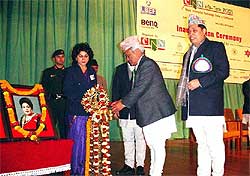 When the government made public the country's first information technology policy in November 2001, it scarcely created a ripple. A few private sector players in Kathmandu were involved, but few talk about it now. The famous "IT Park" in Nepal's own cybercity of Banepa is in limbo. When the Indians stepped in last year with an offer to set up an optical fibre backbone, it stirred little interest among the general public.
When the government made public the country's first information technology policy in November 2001, it scarcely created a ripple. A few private sector players in Kathmandu were involved, but few talk about it now. The famous "IT Park" in Nepal's own cybercity of Banepa is in limbo. When the Indians stepped in last year with an offer to set up an optical fibre backbone, it stirred little interest among the general public. Despite the large turnout of young Nepalis at the annual CAN Info-Tech fair in Kathmandu in January, IT has failed to fire the imagination of the public. Our IT policy lays out the dream that Nepal could leapfrog into the information age and create jobs. But aside from a few call centres, transcription sites and small scale software development, Nepal is way behind the big regional players like India in hitching its wagons to the information revolution.
"We got bypassed by the industrial revolution, and at the rate we are going we'll be by-passed by the information revolution as well," says one IT enterpreneur.
The government's Employment Promotion Council in partnership with a private company, trained more than a thousand youths in medical transcripting with a promise of jobs at the end of the program. The response was astonishing, but the youngsters never got the promised jobs.
Similarly, the government announced 50,000 lower, medium and higher level computer skills training slots for youths with qualifications higher than SLC within three years, and Rs 200 million was allocated for the last fiscal year's activities. The selection procedure was completed but the training never took off, with the authorities citing the security situation.
According to the Computer Association of Nepal (CAN) there are over 500 IT and IT-related companies, and more than 100 training institutes run by private operators. Some techno-savvy bureaucrats have been pushing for computerisation of government database and services, and the Ministry of Science and Technology is involved in the font standardisation for Nepali. The government's ambitious IT policy in the new five year plan envisages putting Nepal on the global IT map and exporting software and hardware worth Rs 10 billion by 2005.
But many see this as little more than a dream. "At this pace we'll never catch up with rest of the world," says Lochan Lal Amatya, president of CAN. IT has an extremely high rate of obsolescence so training for applications appropriate for Nepal is important.
Digital technology can be a vital means to address Nepal's underdevelopment, but it cannot be expected to generate the solution on its own. The government needs to be more forthcoming to be able to use IT to execute solutions to poverty.
"We have no choice, we either take advantage of the technology that is available, or the technology will leave us behind," says CAN General Secretary Atma Ram Ghimire.
The government could have left innovation and applications to the private sector and concentrated on bringing the digital age to under-developed areas. But even here, say experts, it has failed. The capacity of information technology to bridge the gap between rich and poor has been squandered, and we see within Nepal the same digital divide as we see globally between North and South.
"Technology is created in response to market demand, and not the needs of poor people who have little purchasing power. Nepal's IT sector is very much driven by that and the private sector is in no mood to do social service," says Mahesh Man Shrestha, secretary at the Ministry of Science and Technology.
Because of the lack of opportunity, Nepali software programers, designers and hardware experts are migrating in droves. An estimated 2,000 IT graduates enter the job market annually, but most of them head out the first chance they get.


